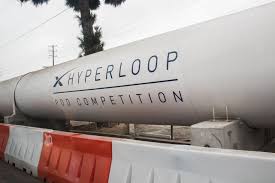Hyperloop One unveils the first prototypes of its high-speed train in Dubai.
A California company has announced the upcoming launch of a high-speed transport line between Dubai and Abu Dhabi in the United Arab Emirates. Thanks to Hyperloop One, this 140-kilometer journey can be completed in less than 15 minutes, aboard capsules propelled by a magnetic field in a tube maintained at low pressure.
Traveling at the speed of light is probably not yet for tomorrow, but recent innovations in transportation still help to gain a little speed. Last of these, that of an extraordinary system of capsules with magnetic levitation able to move up to 1,200 kilometers per hour: Hyperloop One.
Scheduled to be launched in 2020, the project is one of the first concrete applications of the Hyperloop technology developed by the famous Elon Musk, responsible, among other things, for the recent takeoff of the Falcon Heavy rocket. Financed by recent investments by Virgin Group leader Richard Branson, Californian company Virgin Hyperloop One is one of the first in the world to test such a high-speed transmission line.
During Innovation Week, held only a few days ago in the United Arab Emirates, the firm unveiled more about its project, introducing the first prototypes of Hyperloop One capsules and their next application in the field. country.
Dubai-Abu Dhabi in just a few minutes
The soon-to-be-operational route will connect Dubai to Abu Dhabi, a 140-kilometer journey that takes a good hour and a half by car today. A long journey that could soon be a thing of the past, thanks to Hyperloop One. On board its capsules indeed, only a dozen minutes will be necessary to travel between the two cities of the Persian Gulf, according to the American firm.
This feat is made possible thanks to the innovative technology of the Hyperloop system. "Hyperloop One is focused on a much more efficient, fast and clean transport that will change the dynamics of how we transport goods and people," said Shervin Pishevar, Executive Chairman of Hyperloop One. This new generation "train" indeed travels not in the open air, but inside a tunnel maintained at very low pressure, in order to minimize the friction caused by the air.
Another particularity: for Hyperloop, no rails or conventional wheels, but rather an ingenious electromagnetic propulsion system. Induction motors distributed along the track generate a magnetic field capable of propelling the capsules at full speed in the almost absolute vacuum of the tube in which they circulate: no more than one millibar, a thousand times less than the atmospheric pressure.
A caring company with its passengers
Each capsule can carry a dozen passengers at a time. Travelers comfortably seated in leather-covered seats, designed by the BMW car manufacturer. A luxurious seat that will allow them to enjoy high-definition screens installed on board to compensate for the lack of windows. "There will be interactive entertainment screens built into the seat armrests," said Abdulredha Abu Alhassan, executive director of the Dubai Roads and Transport Authority.
By 2021, Virgin Hyperloop One plans to deploy three lines of its ultra-fast transport system, including one between Pune International Airport, India, and the city of Mumbai, all in 25 minutes in hand. This is enough to multiply the number of passengers while the Dubai-Abu Dhabi line alone should generate traffic of nearly 10,000 passengers per hour to each of the destinations. An ambition that is in line with the goal of the Dubai Roads and Transport Authority of 25% of autonomous transport by 2030.
However, crucial steps have yet to be taken for Hyperloop One before the commissioning of these lines. If train prototypes have already been tested, the speeds achieved remain for the moment "moderate". The last record set in December 2017 on the DevLoop website was 387 kilometers per hour. According to the firm, all components of the system have been successfully tested in this third phase but the transport has yet to gain speed.
Even though Hyperloop One's capsules will not reach the speed of light, in the future they will allow thousands of passengers to travel almost as fast as the sound. A big-bang in the field of transport with two fingers to reach the supersonic bang.



Comments
Post a Comment